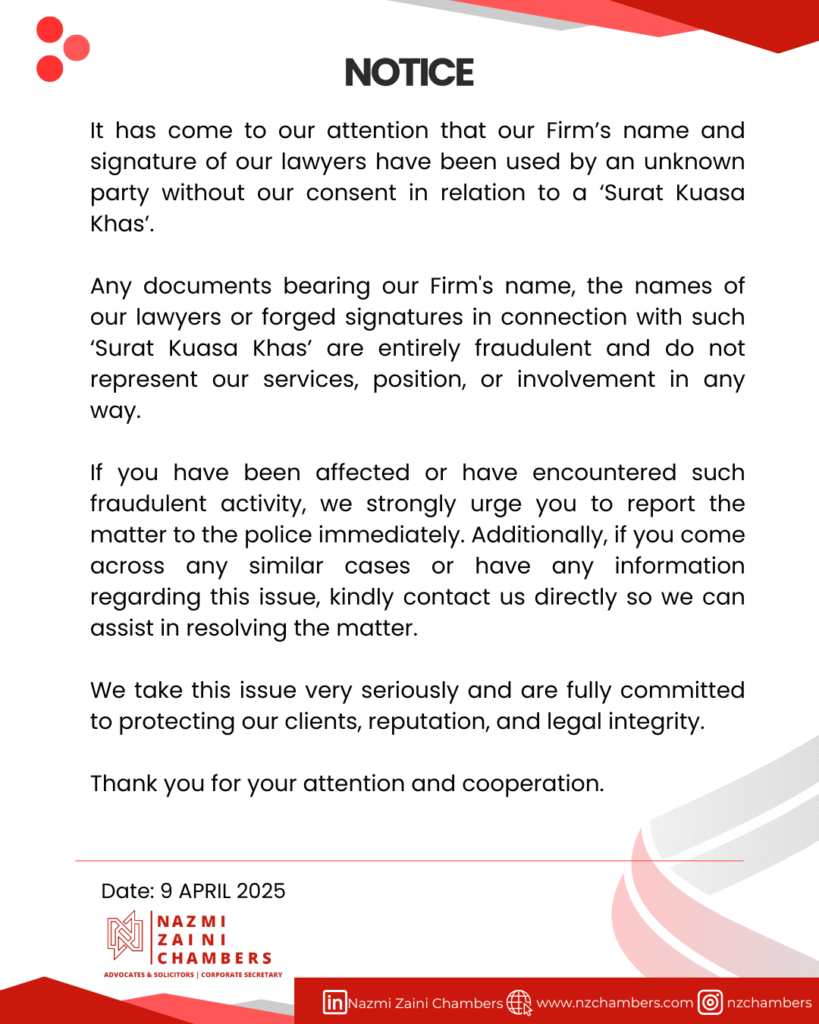Rent To Own in Malaysia: Beyond Housing and Into Affordability for All?
In today’s challenging economic climate, traditional homeownership or outright purchase of valuable assets such as property, business equipment, or appliances, is becoming increasingly out of reach for many. As affordability concerns grow, the rent-to-own (RTO) model is emerging as a practical alternative. RTO promises flexibility and gradual access to ownership, making it especially appealing to individuals and businesses with limited upfront capital.
A new RTO scheme by the government is anticipated under the 13th Malaysia Plan, with early indications pointing toward the formation of a housing consortium to ensure more efficient and sustainable management of the RTO scheme. However, no formal release of the plan has been made public to date. The government’s focus appears to center on improving housing affordability, with limited mention of broader applications such as machinery, office assets, or household equipment. At this stage, it remains unclear whether the scheme will require licensing or specific regulatory oversight. If implemented effectively, the RTO model could offer structured alternatives to outright ownership while enhancing access for underserved populations and for business start-ups.
What is Rent-To-Own?
Rent-to-Own (RTO) is a hybrid financial arrangement where an asset, typically real estate, machinery, or appliances, is leased to a user for a fixed period, with the option or obligation to purchase the item at the end of the lease term. It combines elements of both leasing and financing, making it an attractive alternative for individuals or businesses that may not qualify for traditional loans or want to avoid large upfront payments.
There are generally two components in an RTO deal:
- Lease Agreement – The user (tenant or lessee) pays periodic rent (e.g. monthly) to use the asset.
- Purchase Option/Agreement – The user has the right (or in some cases, the obligation) to purchase the asset at a predetermined time and price.
RTO schemes are commonly used in housing, especially for first-time homeowners, but can also be applied to computers, industrial equipment, and business machinery. For example, small and medium-sized enterprises (SMEs) may use RTO to acquire equipment like Computer Numerical Control machines (CNC), commercial kitchen equipment, or office hardware without immediate capital expenditure.
Although it is not common to use the RTO scheme for other than housing purchase, RTO arrangement can be done and should be commonly used and accepted especially for business-to-business services as it provides more accessibility.
Governing Laws
In Malaysia, there is currently no standalone legislation dedicated solely to RTO arrangements. Instead, the legal position of RTO is shaped by a combination of existing statutes, with their applicability depending on the structure of the arrangement and the type of asset involved. For property-based RTO, the relationship between the parties is primarily contractual in nature and therefore governed by the Contracts Act 1950, while the National Land Code 1965 regulates any dealings in or transfer of interests in land. The Stamp Act 1949 also plays a role, as stamp duty becomes payable, generally only when the purchase option is exercised, marking the legal transfer of ownership.
Where the RTO arrangement is structured on Islamic finance principles, most notably through an ijarah muntahiah bi al-tamlik (lease ending with transfer of ownership) model, it comes under the purview of the Islamic Financial Services Act 2013 (IFSA)[1]. The IFSA empowers Bank Negara Malaysia to set Shariah-compliant standards, prudential requirements, and consumer protection measures, including provisions modelled on the Hire Purchase Act 1967 (HPA) to safeguard lessees in the event of repossession[2]. This is particularly important as RTO arrangements, while almost similar in concept to hire purchase, are not covered by the HPA unless the asset falls within its limited statutory scope of consumer goods including vehicles, furniture, and electrical appliances.
The HPA stands in contrast to RTO by providing a comprehensive statutory framework that prescribes mandatory terms such as a minimum deposit requirement, clear repossession procedures, and restrictions on enforcement, as well as limited to consumer goods. In an HPA-governed transaction, ownership remains with the financier until the final instalment is paid, and the law imposes strict conditions to protect the hirer’s rights.
By comparison, RTO transactions structure rely almost entirely on the wording of the contract and the application of general law principles, which can lead to variability in protection and enforcement. It also provides wider financing option as RTO is not only limited to consumer goods as in the HPA[3].
This fragmented legal landscape means that RTO, unlike hire purchase, operates without a unified legislative framework. Its legal enforceability, consumer protection features, and risk allocation are therefore dependent on how the agreement is drafted and whether the parties have voluntarily incorporated safeguards from other legislation such as the HPA.
How does RTO work compared to others?
RTO arrangements do more than just spread-out payments, they offer a flexible legal structure that can be tailored to meet the needs of both asset owners and potential buyers. One of the key advantages lies in how ownership is handled. Instead of requiring an immediate transfer of legal title, RTO allows the user to enjoy and operate the asset first, while keeping the option to purchase at a later stage[4]. This structure is especially attractive to businesses or individuals who want to avoid large upfront capital commitments, yet still secure future ownership.
Hire purchase, on the other hand, operates differently. The significant difference on its features is on the ownership. While legal title remains with the owner until the final instalment is paid, the hirer is treated as having possession and control of the goods from the outset and is deemed to be hiring them under the hire purchase agreement.[5] The requirement for a substantial initial deposit, often at least 10% of the purchase price, which also means stricter governance on the payment, while RTO does not require any upfront payment as much as the minimum 10% payment as a deposit of the purchase price[6]. By contrast, RTO reserves the option to purchase without locking the user into a binding ownership commitment from day one, allowing them to exit at the end of the rental term with far less financial loss if they decide not to buy.
As RTO is not regulated by any statute as of today, this flexibility also allows parties to allocate risk in a way that suits their circumstances. For instance, in many cases, the risk of damage or loss can be assigned to either the user or the owner depending on how the agreement is drafted, offering commercial certainty in situations such as accidents, theft, or natural disasters. Moreover, the remedies available in the event of non-performance can also be customised. Sellers can retain rights to repossess the asset or recover certain payments, while users may benefit from clear exit options if business conditions change. This makes RTO far less rigid compared to traditional hire purchase or fixed-term financing, especially when the ownership is still being retained by the seller or the owner.
From a tax and compliance perspective, RTO agreements may also offer advantages. For instances, stamp duty is only triggered when the purchase option is exercised and not at the lease stage, as there is no transfer of ownership until the parties decided to proceed with owning the property and/or the goods[7]. This deferred obligation, however, is only because of lack of statutory obligations especially in the Stamping Act 1949, which does not cater to the RTO schemes, unless and until the parties come to the definite instrument that is subject to the ad valorem stamp duty.
Conclusion
In essence, the legal structure of RTO is not just about formality, but it is a tool that gives both parties breathing space, flexibility, and protection. When properly structured, it encourages ownership without the burden of immediate financial or legal commitment, which is exactly why RTO scheme should be promoted at large.
However, without a proper legislative framework specifically governing RTO, the scheme will always be exposed to uncertainty and uneven enforcement. In the absence of statutory safeguards, such as those provided under the HPA for hire purchase transactions, there is no guaranteed recourse if disputes arise, no uniform repossession procedures, and no standard minimum protections for consumers. This lack of regulation leaves buyers less secure, exposes them to potentially one-sided terms, and can undermine confidence in RTO as a reliable pathway to ownership.
Article written by Zahid Zulkifli and Ilya Nadhirah
[1] Nor et al. (2021) Legal issues of ijarah contract and rent-to-own scheme: An analysis. Journal of Legal, Ethical and Regulatory Issues, 24(S5), 1-8 retrieved at <https://www.abacademies.org/articles/Legal-issues-of-ijarah-contract-and-rent-to-own-scheme-1544-0044-24-S5-774.pdf>
[2] Ibid
[3] First Schedule of the Hire Purchase Act 1967
[4] Goh, P. P. N., Tobi, S. U., & Jasimin, T. H. (2023). Review of risk management in Rent to Own (RTO) scheme in Malaysia. Journal of the Malaysian Institute of Planners, 21(3), 225-242 retrieved at <https://eprints.utm.my/102301/1/PennyGohPeiNei2023_ReviewOfRiskManagementInRentToOwn.pdf>
[5] Zakuan, Z. Z. M., Hassan, S. A., & Ismail, N. (2025). Consumer protection in Malaysia and the role of the Hire-Purchase Act 1967 in the contract for the supply of goods. International Journal of Law, Government and Communication, 10(39), 363–375. https://doi.org/10.35631/IJLGC.1039025
[6] Ismail, S., Choong W. W., Hamid, H. A., Mustapha, N. F., Ho, G., Tan, T. T., Kamaruzuki, M. N., & Mohamed Firouz, A. M. (2019). Rethinking Housing: Between State, Market and Society: A Special Report for the Formulation of the National Housing Policy (2018–2025), Malaysia. Kuala Lumpur: Khazanah Research Institute. Retrieved from https://www.krinstitute.org/assets/contentMS/img/template/editor/Rethinking%20Housing%20%28Full%20Report%29-%20EN%20Version.pdf
[7] See footnote 4





